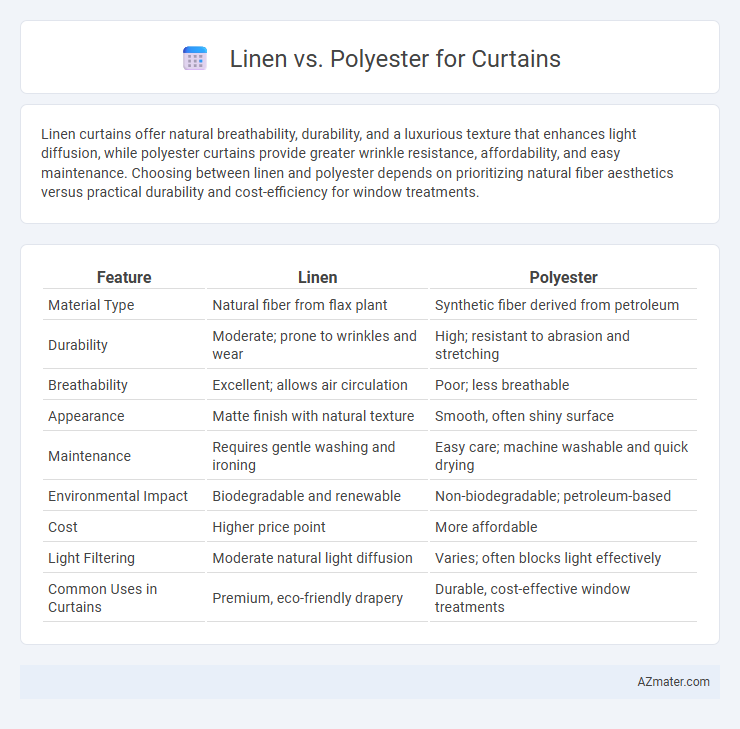Linen curtains offer natural breathability, durability, and a luxurious texture that enhances light diffusion, while polyester curtains provide greater wrinkle resistance, affordability, and easy maintenance. Choosing between linen and polyester depends on prioritizing natural fiber aesthetics versus practical durability and cost-efficiency for window treatments.
Table of Comparison
| Feature | Linen | Polyester |
|---|---|---|
| Material Type | Natural fiber from flax plant | Synthetic fiber derived from petroleum |
| Durability | Moderate; prone to wrinkles and wear | High; resistant to abrasion and stretching |
| Breathability | Excellent; allows air circulation | Poor; less breathable |
| Appearance | Matte finish with natural texture | Smooth, often shiny surface |
| Maintenance | Requires gentle washing and ironing | Easy care; machine washable and quick drying |
| Environmental Impact | Biodegradable and renewable | Non-biodegradable; petroleum-based |
| Cost | Higher price point | More affordable |
| Light Filtering | Moderate natural light diffusion | Varies; often blocks light effectively |
| Common Uses in Curtains | Premium, eco-friendly drapery | Durable, cost-effective window treatments |
Introduction to Linen and Polyester Curtains
Linen curtains offer natural breathability, durability, and a soft texture that enhances light diffusion while providing a timeless aesthetic ideal for eco-friendly interiors. Polyester curtains are known for their affordability, wrinkle resistance, and ease of maintenance, featuring synthetic fibers that ensure longevity and vibrant color retention. Choosing between linen and polyester curtains depends on preferences related to texture, durability, and environmental impact within interior design.
Material Composition and Properties
Linen curtains, made from natural flax fibers, offer excellent breathability and moisture-wicking properties, making them ideal for maintaining a fresh environment in living spaces. Polyester curtains, composed of synthetic polymers, provide superior durability, resistance to wrinkles, and colorfastness, ensuring long-lasting vibrant appearance with minimal maintenance. The choice between linen and polyester hinges on prioritizing natural texture and environmental benefits versus enhanced resilience and ease of care.
Aesthetic Appeal and Texture Comparison
Linen curtains offer a natural, breathable texture with a soft, matte finish that enhances rustic and elegant interior styles. Polyester curtains provide a smoother, shinier surface with higher durability and resistance to wrinkles, making them ideal for modern, easy-care environments. The tactile contrast between linen's organic feel and polyester's synthetic smoothness significantly impacts the room's visual warmth and ambiance.
Durability and Longevity
Linen curtains offer natural strength and breathability, providing excellent durability while maintaining a luxurious texture that softens over time without losing integrity. Polyester curtains are highly resistant to wear, wrinkles, and fading, making them extremely long-lasting and low-maintenance in high-traffic areas. Choosing linen ensures an eco-friendly, aging fabric with sustained resilience, whereas polyester excels in toughness and resistance to environmental damage.
Light Filtration and Privacy
Linen curtains offer a natural, breathable fabric that allows moderate light filtration while maintaining a soft, diffused glow, ideal for preserving privacy without completely blocking sunlight. Polyester curtains provide superior durability with denser weaves that block more light, enhancing privacy by limiting visibility from outside and offering better room darkening capabilities. Choosing between linen and polyester depends on balancing the desire for natural light diffusion against the need for enhanced privacy and light control.
Maintenance and Cleaning Requirements
Linen curtains require gentle care, including hand washing or dry cleaning, to maintain their natural fibers and prevent shrinkage or damage. Polyester curtains are more durable and low-maintenance, offering machine washability and quick drying, making them ideal for households seeking easy cleaning solutions. Both materials resist wrinkles, but polyester's stain resistance and color retention provide superior long-term ease in upkeep.
Environmental Impact and Sustainability
Linen curtains offer superior sustainability due to their natural fibers, biodegradability, and lower water and chemical usage during cultivation compared to polyester, which is a synthetic fabric derived from petroleum and contributes to microplastic pollution. The production of linen supports renewable agricultural practices and sequesters carbon, whereas polyester manufacturing emits significant greenhouse gases and relies on fossil fuels. Choosing linen curtains minimizes environmental impact, promotes eco-friendly home decor, and supports sustainable textile industries.
Cost and Affordability
Linen curtains tend to be more expensive due to the natural fibers and labor-intensive production process, often ranging from $30 to $60 per yard. Polyester curtains offer a more affordable alternative, with prices typically between $10 and $25 per yard, making them ideal for budget-conscious consumers. The cost difference is significant, with polyester providing durable, low-maintenance options at a fraction of linen's price.
Ideal Uses and Room Suitability
Linen curtains offer breathability and natural texture, making them ideal for living rooms and bedrooms where soft light filtration and a relaxed ambiance are desired. Polyester curtains provide durability, wrinkle resistance, and moisture tolerance, making them suitable for kitchens, bathrooms, and high-traffic areas requiring easy maintenance. Both fabrics serve distinct room functions, with linen favored for aesthetic appeal and polyester for practicality.
Which is Better: Linen or Polyester Curtains?
Linen curtains offer superior breathability and natural texture, enhancing indoor air quality and providing a timeless, elegant look ideal for living spaces with ample sunlight. Polyester curtains are more durable, resistant to wrinkles, stains, and fading, making them a practical choice for high-traffic areas or rooms with high humidity. The choice between linen and polyester depends on whether aesthetic appeal and natural fibers or durability and easy maintenance are the priority for your home decor.

Infographic: Linen vs Polyester for Curtain
 azmater.com
azmater.com